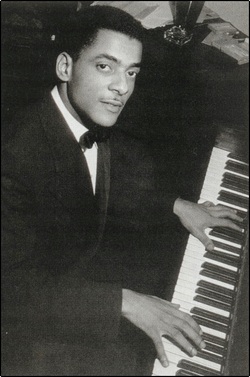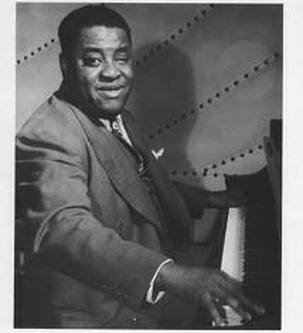 BORN 1912, DIED 1986 MUSICAL SELECTION: "Blues in C Sharp Minor", "My First Impression of You" One of the most urbane and accomplished pianist/leaders to come to prominence in the 1930's, Wilson was born in Austin, Texas, but grew up in Tuskegee, Alabama, where his father was English master and his mother librarian at Tuskegee University. Young Theodore learned violin and piano as a youth, discovering jazz from 78rpm records while he was studying for a music major at Talladega College. After a move to Detroit in 1929 Wilson began playing with local bands, including Speed Webb, for whom he made many arrangements, staying until 1931, when he moved via Toledo to Chicago, initially working with Erskine Tate before also playing with Louis Armstrong and Jimmie Noone. Wilson's arrival in New York in 1933 to play with Benn Carter presaged the beginning of his larger reputation. Recording with the Chocolate Dandies for John Hammond (who had arranged his transfer from Chicago), Wilson was quickly appreciated among New York musicians for his rock-steady left hand, his harmonic sophistication, and his immaculate righ-hand technique. He was also an inspired arranger, whether for small or large groups, and he was the perfect musical coordinator for the decade-long series of recordings undertaken by Brunswick and featuring assorted personnel, often with singer Billie Holiday as the focal point. These recordings, especially those featuring Holiday in tandem with Lester Youn, have justly become regarded as some of the crown jewels of jazz recording. By 1935 Wilson had been inducted into the Benny Goodman setup, initially as part of his Trio (one of the first racially mixed groups of the swing era), recording and touring with the leader as a separate musical unit to his big hand. Wilson's superb left hand, providing accurate rhythmic and harmonic support, knitted the group's efforts together while his righ-hand counterpoint added the dimension of musical converstion which led Goodman's group to be termed the first exponents of "chamber jazz." In 1936 Lionel Hampton's arrival made it a quartet and one of the most popular small groups in jazz history. Wilson left in 1939 to form his own short-lived big band. After its demise in 1940 he formed a sextet, which appeared regularly at Cafe' Society in New York and recorded for a number of labels, especially Musicraft, where he led his own sessions and arranged dates featuring Maxine Sullivan and, from 1946 onward, Sarah Vaughan. By the mid-1940s Wilson was reappearing with Goodman's small groups for short stints, but the rest of the decade was largely taken up with teaching and broadcasting work. Wilson spent most of the latter part of his career involved in teaching and in various music capacities for the broadcaster CBS, interspering this with appearances at major festivals with hand-picked groups (he was with one such band at the 1957 Newport Jazz Festival) or brief reunions with Benny Goodman. The original quartet made a last record together in 1963 and played occasional concerts. Wilson continued to make records up to the time of his death.
0 Comments
 BORN 1910, DIED 1956 MUSICAL SELECTION: "Tiger Rag" For many years regarded as a nonpareil jazz pianist in terms of technique and harmonic imagination, more than four decades after his death Tatum still has few if any peers in these areas. Born in Toledo, Ohio, and from birth suffering from blindness in one and severe limitations in the other, Tatum was drawn to music from boyhood, taking up both violin and piano. By the time he was 13 the violin had been jettisoned in favor of piano, with Tatum receiving some formal training while at Toledo School of Music. He mastered the Braille method of reading music as well as using powerful glasses to read ordinary manuscripts, but the majority of his learning was done after leaving school. Furing the 1920s he learned from records, piano rolls and other means, perfecting the most effortless stride technique ever heard as well as embarking on his lifetime fascination with ever more sophisticated chord substitutions and elaborate rearrangement of popular tunes, overlaid by a richly baroque right-hand technique and a uniquely flexible approach to metric time. Tatum was already known by word of mouth before his arrival in New York in 1932, but his debut there as accompanist to Adelaide Hall, followed by an engagement as a solo at the Onyx club and his first recordings (including the legendary "Tiger Rag" at what was commonly acknowledged by other pianists to be an "impossible" tempo) caused astonishment. Tatum was quickly and widely acknowledged as so far ahead of the pack (including his original ido, Fats Waller) as to be in a league of his own. By the mid-1930s he was internationally known as a true phenomenon on his instrument, his later piano-guitar-bass trio with Tiny Grimes a model for hundreds of other piano trios to follow in its level of musical interplay. Tatum's fame breached parochial jazz borders, bringing musicians such as Horowitz and Toscanini to Harlem clubs after Carnegie Hall performances to witness his genius. His innovations, often skirted by pianists overawed by his technique, were most successfully incorporated by sax players, from Coleman Hawkins onward, who were able to transfer Tatum's quicksilver harmonic thinking to their melody instruments. Tatum's popularity took a tumble in the late 1940s as jazz fashions changed and other, more startling and energetic styles came to the fore. However, in the 1950s he signed to Norman Granz's label and began in 1953 on a project to record one of the taped over the next three years, is available on CD on the Pablo label: the solo performances alone take up seven CDs, while the group performances range from a trio session with bass and drums to separte dates with Roy Eldridge, Ben Webster, Benny Carter, Lionel Hampton, Buddy DeFrance, and Harry Edison. Tatum was often criticized for being an overwhelming accompanist: here he shows that, with player of commensurate stature, he complements busily but always appositely. With the solo performances, he so thoroughly rethought the standards he played that they became vessels for his own musical messages. Tatum died in 1956 |
Jazz LegendsA blog on the great legends in Jazz. Information via "The Encyclopedia of Jazz and Blues". Archives
December 2017
Categories |
 RSS Feed
RSS Feed

